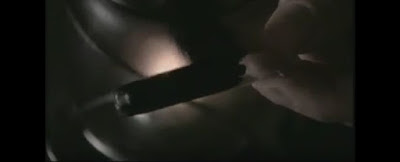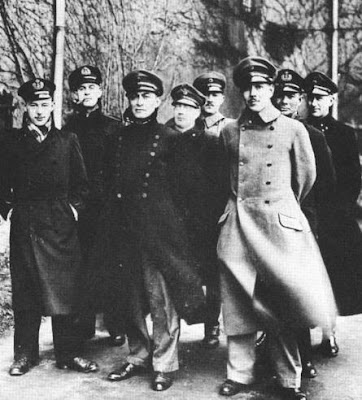 |
| 2nd Lieutenant Oscar Drijber & Major Cornelis Giebel - wikiwand.com & IWM |
Saturday 20th September 1941 was the revised date for Dutchmen Major Cornelis Giebel and 2nd Lieutenant Oscar Drijber to attempt their escape. They planned to leave on the Friday, but there had been a problem at the castle around the daily park exercise. Giebel recorded:
‘Drijber and I joined the others of the walk party in front of the closed doors at the gateway. We were however quite amazed to see this time the walk party numbered more than twice its usual number. Instead of about eighty, there were now some two hundred. When the doors were opened, we pushed our way through to the outer courtyard where our thirty German guards were waiting for us….
 |
| Captain Paul Priem - www.strijdbewijs.com |
But things went wrong. Was it only accidental that Captain Priem was on the spot? Confronted with two hundred park walkers instead of the usual eighty, he at once understood that something was brooding. But he knew how to handle the situation. With an ironic smile he addressed the POW crowd, apologising that apparently it had not become known in time that on this Friday the walk in the park had been cancelled. He regretted that we had not been warned earlier and suggested that we should forthwith retire behind the walls of our inner courtyard.
We could do nothing but obey.’
Once back in his quarters Giebel learned that other POWs had
discreetly been asked to take exercise in the park on the Friday as they might
be needed for ‘camouflage purposes’. The response had been a little over
enthusiastic.
On the following day a key football match in the prison ‘Olympic Games’ was to be played in the park between the Polish and Dutch teams. The opening ‘ceremony’ had taken place in the castle courtyard on 31 August. Volleyball, handball and football competitions had commenced after this.
 |
| Colditz volleyball |
Giebel and Dijber consulted Dutch escape officer Captain Machiel van den Heuvel who sanctioned all attempts. They were ready to try again if their park exercise was allowed. (Following events on the previous day and recent Dutch escapes, German Lieutenant Paul Priem had stopped the Dutch going to the park.)
 |
| Cpt van den Heuvel - The Colditz Story |
Due to the football match; the ‘camouflage’ around the manhole cover would now need careful adjustment whilst the men gained access and dropped in to the shaft. The previous tactic of a circle of men throwing a ball around the group (see past posts) was not viable as the football pitch was very close.
Concealing the men’s absence on the park exit headcount also had to be looked at again. Contact with the Polish POWs had been made on this.
On the afternoon of the 20th, the Dutch and Polish football teams and their supporters assembled with other POWs in the courtyard for the count and march down to the park. The Feldwebel in charge referred to the German’s recent instruction and refused to allow Dutch supporters to accompany their team to the park.
 |
| Castle Entrance |
The Dutch players protested, complaining that they could not play the match without supporters. During the impasse, one of the Polish POWs accused the Feldwebel of interfering with the Kommandant’s personal wishes, which stated that the POWs should be allowed to play the ‘Olympic Games’ amongst themselves. The Feldwebel eventually conceded and the POWs lined up to be counted.
Two of the smallest Poles in the camp had positioned
themselves amongst the lines. Each man clamped his legs around a fellow POW’s
thighs whilst someone either side supported him by the elbows. The man in the
middle wrapped his overcoat and some blankets around the hidden POW and was
able to open a newspaper to complete the deception. Once the count was taken,
the two extra men stood up and merged into the column unnoticed. In the event
of a numerical check being made before entry into the park, the process would
be repeated.
Initially it is difficult to understand why this ruse was
not spotted. POWs were in rows and a diligent observation and count would
surely detect the concealed men. The reality was not that straightforward. The two
Poles were very small, and men often lined up in a haphazard testing way,
pushing their luck as far as they could stretch it. Hauptmann Roland Eggers
gives an accurate picture of what the Germans had to contend with around the congregation
and line up for the park exercise:
‘First the assembly, stage one, getting the party out of the yard. Then stage two, falling them in, in five ranks, for the count outside the guardroom. No one was ever in a hurry. People stood around chatting. ‘Zu funf, meine Herren,’ bawled our NCO in charge. No one moved. ‘Guard turn out’.
Those for the walk eventually started to line up, in fives.
Gradually the prisoners drifted into ranks, ‘close up here, cover off there’
and then the count. Someone moved, someone shuffled, someone dropped his
football, someone had to be shouted out of his book. Perhaps a recount was
necessary, and then another one, and finally the total was written down…’
What
Eggers omits are the attempts to infiltrate the exercise party by POWs in
borrowed uniforms if punishments were in operation. Recognition and removal of
the offenders further disrupted the process.
He further adds about the POWs:
‘…pointing, calling back, calling forward, dropping things,
causing the whole time some kind of diversion.’
 |
| Diagram of park and enclosure - E H Larive |
Giebel and Drijber entered the park enclosure with the other
POWs. The headcount had agreed with numbers leaving the castle earlier. There must have been a tentative rush of
optimism. If they were able to hide in the manhole shaft, the two Polish POWs could
easily take their place in the counts taken before exit from the park and back
at the castle entrance.
Once again the Dutch had played another clever card. The next hand would be more testing, as the nut and bolt had to be removed from the manhole cover and replaced with a false one without the guards seeing. This time Giebel and Drijber had to make best use of the football match and spectators. Giebel described what happened once the match was in progress:
‘The Dutch supporters seemed to be not content with the place where they were standing, which was muddy, so we moved forward a few feet across the touchline in the direction of the manhole. When a few minutes later we moved forward again, the players objected and said we were spoiling their game and should keep off the field. But that did not stop us from moving step by step, nearer to the manhole.’
A screen formed around the manhole again and work began with the home-made spanners to remove the nut and bolt. Whoever screwed on the nut last had done a thorough job. It was hard to remove; work had to be done intermittently and discreetly. Only ten minutes of the game remained when the manhole cover was finally opened. Giebel and Drijber climbed down the rungs to the bottom of the shaft and the false bolt and nut were cosmetically secured in position without the guards noticing. It was a masterstroke, as the grey paint on the carved wooden bolt and glass tube which had once contained aspirin looked authentic.
 |
| Aspirin bottle being painted - You Tube Oflag IV.C |
The missing men’s absence would only be covered by the two Polish POWS on the counts before exit from the park and at the castle entrance. As with previous manhole escapes, Giebel and Drijber had to be patient until they could exit the shaft once it was dark. The key to the whole operation once the exercise party had been checked back in at the castle was to mask the absence at evening appell.
Dutch escape officer van den Heuvel had seen the advantages to escaping POWs if their absence could be concealed for as long as possible. Escapers Dufour and Smit had benefited from this before their recapture at the Swiss border when on the brink of freedom (see past posts). His plan was simple. POW headcount numbers at each appell must include the two missing escapers. It was time to play the Dutch joker card ‘Max’ and ‘Moritz.’
Van den Heuvel had managed to acquire a sack of ceiling plaster by bribing a workman in the castle. In most POW camps there was usually a raft of trades and talents amongst the prisoners. A sculptor fashioned two life sized busts which were then painted by Lieutenant Diederick van Lyden. Two iron hoops were added around the pedestal part of the bust which was then shaped to rest on a man’s arm. A shirt collar and tie were fitted around the neck and a long Dutch overcoat draped over the bust’s shoulders. Another neat twist was when not being shown, the bust hung suspended under the forearm of the handler, hidden in the folds of the overcoat. To an observer it looked like the POW was carrying the coat on his arm.
 |
| Lieutenant Leo de Hartog seen with 'Moritz' Note the size of Hartog's boots, similar of which would fit under 'Moritz's' overcoat and blend in to a tight line of POWs. - IWM |
When the bust needed to stand in at a head count, the handler unfolded the overcoat, raised the dummy up and put an army cap on its head. The impostor was then held at shoulder height by a shortened broomstick pushed through the hole in the bust’s neck. The handler kept his arm at elbow height, concealing it amongst the overcoat. A pair of high military boots were placed at attention under the bottom of the coat by another POW.
Somewhere amongst the rows of men at evening appell ‘Max’, ‘Moritz’ and their handlers did the job to perfection. Giebel and Drijber waited until it was dark, pushed up the manhole cover, breaking the glass ‘bolt’ and making their escape after gathering up the shards of glass. ‘Max’ and ‘Moritz’ covered five more appells before van den Heuvel dropped the ruse and allowed the missing numbers to be discovered. By then Giebel and Drijber had a thirty six hour start and were well on their way to the Swiss frontier.
 |
| 'Moritz' (middle) on parade - IWM |
 |
| Dutch POWs with 'Moritz' - IWM |
 |
| Glass bolt in position would have looked something like this, but with a nut attached - You Tube Oflag IV.C |
 |
| Swiss German Mountains - travellerspoint.com |
The final ace was played whilst Giebel and Drijber were being held by the neutral Swiss authorities in Berne. They were able to write an innocent looking letter which was coded and contained detailed intelligence around their escape. (past posts cover coded letters from POWs). The letter reached the POWs in Colditz, was decoded and assisted future escapes.
The manhole was not used again until 24 November when a
sentry noticed two men entering it during the park exercise period. Lieutenants
Geoffrey Wardle RN and Jerzy Wojciechowski (Poland
Sources
Colditz The Full Story - Major Pat Reid MBE MC (Highly recommended read)
The Man Who Came in From Colditz - E H Larive (A must read if you can find a copy)
Colditz The German Viewpoint - Reinhold Eggers (Highly recommended read)
Author's Notes
No comments:
Post a Comment